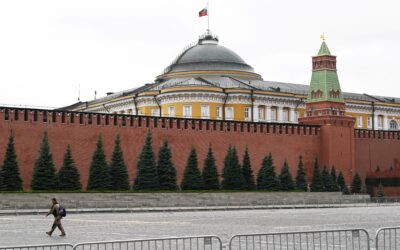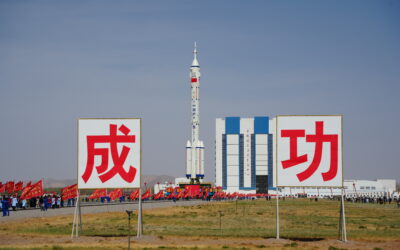
Russia’s Response to U.S. Aid: Shrugs, Disinformation and Warnings of Nuclear War
SUBSCRIBER+ EXCLUSIVE REPORTING — Russia’s reaction to the new infusion of U.S. aid for Ukraine has ranged from shrugs to fury, from warnings of nuclear […] More
For want of a nail the shoe was lost,
for want of a shoe the horse was lost;
and for want of a horse the rider was lost;
being overtaken and slain by the enemy,
all for want of care about a horse-shoe nail.
Benjamin Franklin, The Way To Wealth, 1758
OPINION — The Government Accountability Office (GAO) last week reported there is a long-standing need to upgrade the government’s ground-based Satellite Control Network (SCN) that currently supports 170 satellites for the Defense Department, Intelligence Community and National Aeronautics and Space Administration.
DOD has reported that each fiscal year, SCN supports the launch of satellites worth a total of $14 billion and preserves over $4 billion worth of satellites through emergency support.
The need is fast growing because Space Force officials told the GAO that the expected number of satellites requiring SCN support is expected to nearly double by 2027. That’s because, according to the National Reconnaissance Office, satellite launches are increasing and the lifetime of those already in orbit is extending.
SCN operators are not involved in the offensive and defensive military missions of these satellites, which involve Positioning, Navigation and Timing; Intelligence, Surveillance and Reconnaissance; Missile Warning and Missile Defense; Communications, Weather, Launch Vehicle Support, and Research and Development.
Rather, SCN operators use 19 parabolic antennas at seven locations around the world, plus worldwide ground stations to conduct an average of 450-plus daily contacts just to check on the status of the satellites. As the GAO report put it, the SCN role consists of “(1) tracking — determining the satellite’s location based on position and range measurements; (2) telemetry — collecting health and status reports from satellites; and (3) commanding — transmitting signals from the ground to the satellite to control satellite subsystems such as power supply, antennas, and mechanical and thermal control. These functions…ensure that satellites remain in the proper orbit and are performing as designed.”
These functions can be accomplished by SCN’s worldwide antennas – two in Thule, Greenland; three in Oakhangar, England; three on Diego Garcia Island; three at Andersen Air Force Base, Guam; two at Hawaii Tracking Station; three at Vandenberg Tracking Station, California; and three at New Hampshire Tracking Station, New Boston, N.H. Because there is a limited window of time to make contact with an antenna, the data transfer has to be completed from an antenna to a satellite before the latter passes over the horizon in its orbit and out of contact.
Get your national security daily open source brief by signing up for The Cipher Brief’s Daily Newsletter
One more problem in using the current-but-aging SCN system: Space Force officials told the GAO that each SCN antenna can maintain contact with only one satellite at a time. Therefore, conflicts may occur when two satellite operators attempt to schedule a contact using the same antenna at the same time, so that one operator cannot be accommodated. From January 2021 through June 2022, SCN operators identified 15,780 of these conflicts as a result of schedule conflicts, according to the GAO report.
To determine which contacts will be rescheduled or canceled when a conflict on the SCN occurs, Space Force utilizes a prioritization matrix. This matrix determines the operational priority among the various assets that utilize the SCN and helps Space Force allocate SCN resources to the activity with the highest priority for a particular time and site.
Launches also take up extra SCN time because each launch requires at least two antennas – one to act a primary antenna for the launch, and at least one more for support of the launched satellite.
Space Force officials told the GAO that along with the increase in launches, there also has been and will continue to be an increase in the number of satellites per launch. The officials stated that each satellite launch can now include 20 or more satellites at a time that will rely on SCN for
regular contact, whereas in the past launches would typically include just a single satellite.
Space Force is attempting to increase SCN capacity by reducing so-called pre-pass time – the time allotted prior to the contact with a satellite to ensure everything is configured correctly between a ground station and a satellite. Currently pre-pass time is allotted 10 minutes but, according to Space Force officials, reducing pre-pass time to five minutes could save them approximately 12 days a month of capacity on the SCN while a reduction in pre-pass time to 2 minutes would save them approximately 27 days a month.
Needless to say, the GAO reported that because of the age of the SCN system, “the program often lacks available parts and faces increasing costs to maintain its aging systems.” In addition, “Space Force officials said the power infrastructure for Schriever Space Force Base [in Colorado Springs, Colo.] — SCN’s primary control center — requires modernization to meet current and future demand. Specifically, they noted that efforts to maintain current operations at the
base are unsustainable and mitigation efforts are close to exhausted.”
Back in September 2017, an Air Force Life-Cycle Sustainment Plan (LCSP) was issued which included information key to maintaining and sustaining SCN systems and presented a long-term sustainment strategy for the SCN. When SCN was transferred from the Air Force to the Space Force one of the ongoing challenges of their reorganization has been dividing responsibilities between headquarters staff and the field commands in terms of who has responsibility for the overall SCN architecture.
However, since the Space Force takeover, the SCN program has had some significant changes related to sustainment which were not reflected in the LCSP plan.
In the early 2000 there was a project to update the existing semi-automated electronics on the network’s ground control computers in ground stations and antennas which serves as the point of human-machine interface for the SCN. As of May 2022, they have fully automated the electronic core of all the SCN antennas, and seven of the 19 antennas have received an improved ground station. As of December 2022, improvement of two ground stations is ongoing, according to Space Force officials.
It’s not just for the President anymore. Are you getting your daily national security briefing? Subscriber+Members have exclusive access to the Open Source Collection Daily Brief, keeping you up to date on global events impacting national security. It pays to be a Subscriber+Member.
In the summer of 2022, Space Force initiated a second modernization project that will allow SCN operators the flexibility, through software virtualization, to communicate with multiple antennas with one suite of electronics, whereas the SCN currently can only talk to one antenna with one suite of electronics. The modernization includes stationary as well as mobile antennas which can deploy to an SCN site if a stationary antenna breaks, and they need to maintain the continuity of operations.
Space Force officials told the GAO they plan to develop, procure, and deploy 12 phased-array antennas over the next nine years, each one of which is designed to make contacts from 18 to 20 different satellites at the same time rather than one at a time as with current parabolic SCN antennas. According to Space Force, the cost to acquire all the antennas for the new system is $1.4 billion.
In addition to significantly increasing capacity, maintaining and operating costs will be less because the phased-array systems have no moving parts.
However, while components being integrated into these new phased-array antennas are mature and commercially available, some officials involved said this was “a new use of phased-array technology that requires further development,” according to the GAO report, which added, “GAO’s leading practices classify as an immature technology.”
Officials are also exploring opportunities to leverage other existing government antennas such as five owned by the National Oceanic and Atmospheric Administration (NOAA). They were chosen because of excess capacity, and once upgraded by the end of fiscal 2024 will be used to augment contacts to five satellite systems.
Space Force has considered other government antennas, such as those used by the Army and Navy, but determined that upgrading them to meet SCN specifications would not be cost effective, according to the GAO report.
Another change is in the works for the SCN manual scheduling system, which in 2024 will reach the end of its useful life. Initially, Space Force will replace the current system with an Air Force limited automated scheduling tool. Long-term, Space Force officials are developing a cloud-based system that eliminates manual processes, automates scheduling and integrates with any antenna designed to connect to the SCN system. They also expect the new system will respond to threats by configuring antennas and networks automatically.
Remember that September 2017, Air Force Life-Cycle Sustainment Plan that was going to modernize the SCN and make needed organizational changes within Space Force?
GAO found that delays in approving that plan meant the process should start all over. GAO’s recommendation last week was that “the Secretary of the Air Force should ensure that Space Systems Command updates or issues a new lifecycle sustainment plan that includes information about all the current sustainment strategies, related programs, the updated Space Force organizational structure, and other relevant information for the Satellite Control Network.”
Guess what? The Defense Department concurred.
The Cipher Brief is committed to publishing a range of perspectives on national security issues submitted by deeply experienced national security professionals.
Opinions expressed are those of the author and do not represent the views or opinions of The Cipher Brief.
Have a perspective to share based on your experience in the national security field? Send it to [email protected] for publication consideration.
Read more expert-driven national security insights, perspectives and analysis in The Cipher Brief because National Security is Everyone’s Business
Related Articles

SUBSCRIBER+ EXCLUSIVE REPORTING — Russia’s reaction to the new infusion of U.S. aid for Ukraine has ranged from shrugs to fury, from warnings of nuclear […] More

SUBSCRIBER+ EXCLUSIVE REPORTING — When Chinese President Xi Jinping came to San Francisco last November to meet with President Joe Biden, Chinese pro-democracy activists in […] More

SUBSCRIBER+EXCLUSIVE EXPERT PERSPECTIVE — More than two years after its withdrawal from Afghanistan, the U.S. still does not have a clear way forward in the […] More

SUBSCRIBER+ EXCLUSIVE REPORTING — Ukrainians greeted Saturday’s long-awaited House passage of $60.8 billion in aid with justifiable jubilation. For months, their soldiers, civilians, and political […] More

SUBSCRIBER+ EXCLUSIVE REPORTING — A race for control of space is underway, and just as on earth, the U.S. and China are the top competitors. […] More

SUBSCRIBER+ EXCLUSIVE REPORTING — For nearly a week, the Middle East and much of the world were on a knife’s edge, waiting for a promised […] More
Search